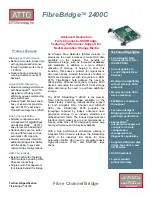
EtherAnt II User’s Manual
Section 1
Overview
1.1 Description
The EtherAnt II™ is a flat panel directional antenna with a built-in wireless Ethernet adapter. The
equipment is 802.11b WiFi™ compliant, operates at up to 11 Mbps and features 128-bit WEP (Wired
Equivalent Privacy) and the new Agere WEP-Plus. The EtherAnt II provides efficient outdoor high-speed
wireless connectivity for desktop PCs, laptop computers and routers equipped with an Ethernet port.
The EtherAnt II offers the simplest, most efficient 2.4 GHz Wireless Internet access solution for an
Ethernet-enabled desktop PC. It will communicate with any Access Point or other wireless client that is
100% WiFi™ compatible. It is ideal for use as a client station device for Wireless Internet applications.
With the wireless client adapter built right into the antenna, there are no complicated hardware
configurations or radio frequency (RF) cables. Because the EtherAnt II has the radio built-in, professional
antenna installation is not required. Once the EtherAnt II is connected, simply install the Client Manager
from the CD-ROM included in the kit and configure the network settings.
Two variations of the EtherAnt II are available: the standard series EtherAnt II with an integral 18 dBi gain
flat panel antenna, and the EtherAnt II –LR with the addition of an integrated bi-directional fixed amplifier
to boost range and improve reception. The antenna housing is waterproof and intended to be a pole or
wall-mounted outdoor installation.
For those customers that have multiple PCs on a LAN, a low-cost Cable/DSL router can be used to
provide a firewall and NAT for their PCs. Access to the internet can be provided with the reassurance of
having the customer's LAN behind a firewall. If a router/firewall is not desired, the EtherAnt II can also be
plugged directly into a customer's LAN. The built-in Micro-routing feature
automatically routes IP packets
for up to 253 MAC addresses on the LAN, no special configuration is necessary!
The Micro-routing algorithm maintains an auto-indexed IP-to-MAC address table by inspecting each
received 802.3 Ethernet frame. Thereafter, the EtherAnt's local MAC address is superimposed as the
source address field within the frame prior to transmitting it on the wireless (802.11b) network.
Reciprocally, whenever a wireless (802.11b) frame is received, the algorithm inspects the destination IP
address and remaps the associated MAC address into the destination field of the Ethernet frame. The
source address field within the frame is then replaced with the EtherAnt's local MAC address prior to
transmitting it on the Ethernet network.
The EtherAnt II does not require that a PC be opened in order to install an interface card provided that the
PC has an Ethernet Network Interface card (NIC). Attach the outdoor Ethernet cable included in the kit
(plus any optional extension cables) to the EtherAnt II. Plug the Ethernet cable into the DC Power
Injector. Connect the built-in Ethernet cable from the DC Power Injector into your computer’s
10/100BaseT port, plug in the AC adapter, and your hardware installation is complete. Because the
EtherAnt II uses the PC’s existing Ethernet interface, there are no drivers to install for this device.
The Windows-based Client Manager provides configuration and diagnostic utilities that allow you to see
vital information regarding the link between the antenna and the base station. Information such as signal-
to-noise ratio, signal strength, and noise level all in dB, provides for efficient installation and aiming of the
antenna, as well as troubleshooting link problems.
The EtherAnt II kit includes a 50 foot outdoor-rated Ethernet cable with a weatherproof connector (longer
cables are available as on option). By using RJ-45 in-line couplers, you can extend the cable up to 300
feet between the EtherAnt II and the DC Power Injector (however the EtherAnt –LR can operate only with
1. Firmware 2.01 and higher
Version 3.3
Page 1
March 2003
Summary of Contents for EtherAnt II
Page 1: ...Version 3 3 March 2003 ...
Page 27: ...EtherAnt II User s Manual Version 3 3 Page 24 March 2003 ...
Page 28: ......





































